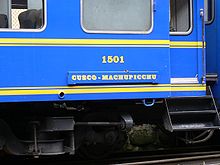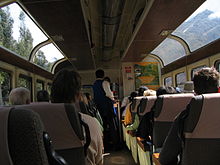- PeruRail
-
PeruRail Locale Peru Predecessor Ferrocarril del Sur (ENAFER) Track gauge 1,435 mm (4 ft 8 1⁄2 in) (eastern)
914 mm (3 ft) (western)Website http://www.perurail.com PeruRail is a railway operator working tourist, freight, and charter services in southern Peru.
The main line between the port of Matarani, Arequipa (the capital of this region is Peru's second city), Cuzco and Puno on Lake Titicaca was formerly known as the Ferrocarril del Sur (Peru Southern Railway), and was for a time owned and operated by the ENAFER state company. It is the second highest railway in the world after the Qingzang railway to Tibet.
From Cuzco, PeruRail provides passenger services on the 3 ft (914 mm) gauge Ferrocarril Santa Ana to Aguas Calientes, delivering tourists for Machu Picchu.
It operates in a 50-50 venture with Orient-Express Hotels and Peruvian partners, namely Lorenzo Sousa Debarbieri.[1]
Contents
Route description
Perurail's routes are divided into two sections; there are no tracks through Cuzco.
The line between Cuzco and Machu Picchu is a 3 ft (914 mm) narrow gauge line, while all other the lines are standard gauge 4 ft 8 1⁄2 in (1,435 mm).
The Cuzco to Machu Picchu route, Ferrocarril Santa Ana, boasts a series of five switchbacks called locally 'El Zig-Zag', which enable the train to climb up the steep incline out of Cuzco before it can begin its descent to the Sacred Valley and then continue down to Machu Picchu. However, this section of the route is currently suspended, and all trains to Machu Picchu leave from Poroy, just outside Cuzco, instead.
From Poroy, the narrow-gauge line goes northwest to Ollantaytambo, where the branch from Urubamba joins, then on to Machu Picchu station in Aguas Calientes. Tracks formerly continued into the jungle, but they were destroyed by recent flooding.
The Cuzco-Puno tracks, formerly Ferrocarril del Sur, start at Matarani port, go through Arequipa and enter Puno Region, where the line splits in two at Juliaca. The eastern branch goes to Puno; the western branch runs into Cuzco.
Currently the only legal way to depart Machu Picchu (actually from the town, Aguas Calientes) is by train; hiking along the train tracks is prohibited. There are no roads from the town and helicopter services have been suspended indefinitely. In addition to the train, visitors can reach Machu Picchu via several inbound hiking trails, including the Classic Trail (four-day trek) from Cuzco, but there is no hiking back the other way on the Inca Trail.
Passenger routes
As of July 2011[update], there are five passenger routes:
- Poroy-Machu Picchu
- Poroy-Machu Picchu (Hiram Bingham)
- Ollantaytambo-Machu Picchu
- Urubamba-Machu Picchu
- Cuzco-Puno
Most trains to Machu Picchu operate from Ollantaytambo; there are three times per day to/from Poroy and one to/from Urubamba.[2]
The following passenger routes are no longer operated:
Trains
On the route from Cuzco to Machu Picchu, PeruRail transports the vast majority of visitors and provides several different services.[3]
The Hiram Bingham Pullman, named for Machu Picchu's American discoverer, Hiram Bingham, is the highest service. It departs from Poroy at 9 a.m., later than other departures. Meals, guides, bus service and entrance to the ruins are included.
Other services include Vistadome services provided by 1965 vintage German Ferrostaal refurbished railcars with large side and overhead windows, allowing views of the mountainous terrain, complete with at-seat refreshments included, and Expedition trains which offer basic service in upholstered seats at a lower price. Snacks are sold and space is provided for backpacks, particularly for Inca Trail hikers.
Although not advertised, PeruRail also offers local trains equipped with wooden seats and that are available only to Peruvian nationals for a fraction of the price charged for tourists.
First class service is also offered on the Andean Explorer train from Cuzco to Puno in refurbished coaches that include dining cars and an open-air observation bar car.
The interiors of the First Class coaches on the Cuzco to Lake Titicaca trains were designed by James Park & Associates, the same company who designed the elegant First Class cabins for Singapore Airlines. The actual work, however, was done in Cuzco by Cusquenian workers. After the refurbishment was completed, a traditional ceremony 'Pago a la Tierra' (payment to Mother Earth), an Andean tradition, was organised to 'bless' the train. A local shaman presided over the ceremony, which involved many traditional rites.
Cuzco-Lake Titicaca
At its highest point, La Raya pass 14°28′59″S 70°59′20″W / 14.48306°S 70.98889°W, the altitude is 4,313 m (14,150 ft). The train makes a stop in La Raya pass where there is an exquisite view over all the plains to the snowcapped mountains, and a beautiful old chapel, standing all alone in the middle of the Andean plateau.
Freight
PeruRail runs daily freight services between the port of Matarani, the city of Arequipa, and the Andean cities of Juliaca, Puno, and Cuzco. Under PeruRail's administration the tonnage transported increased from 460,000 tons during 1999, 573,000 tons in 2000 to 639,000 tons during 2001.
The main products transported by PeruRail are fuel, wheat (for Peruvian and Bolivian consumption), coal, cement, soya flour from Bolivia, coffee, beer and non-alcoholic beverages.
Shipping
The car float Manco Capac operates across Lake Titicaca between PeruRail's railhead at Puno and the port of Guaqui in Bolivia. PeruRail also owns the former ferry SS Ollanta, which was launched on Lake Titicaca in 1931. Ollanta is now refurbished for tourist cruises and PeruRail has leased her out for charter work.
External links
- Main website in Spanish and English
- PeruRail Timetables
- Ladatco Tours
- Peru Rail Map
- Brief historical summary of the railroads in Peru
See also
- Iperu, tourist information and assistance
- Tourism in Peru
- Rail transport in Peru
- Transport in Peru
- Kashmir Railway
- Qinghai-Tibet Railway
Further reading
- Whetham, Robert D. (2008). Railways of Peru. Volume 2 – The Central and Southern Lines. Bristol: Trackside Publications. ISBN 978-1-900095-37-2.
- Daniel Thomas (June-July 2002). "Cuzco to Machu Picchu". Latin Tracks 9: 16–22.
References
- ^ Stock.us.reuters.com – retrieved November 8, 2007.
- ^ Perurail timetables
- ^ www.orient-express.com– retrieved November 9, 2007.
Rail transport in South America Sovereign states Dependencies and
other territories- Aruba
- Bonaire
- Curaçao
- Falkland Islands
- French Guiana
- Categories:
- Rail transport in Peru
- Railway companies
- Mountain railways
Wikimedia Foundation. 2010.
Look at other dictionaries:
PeruRail — Zug von Cuzco vor der Station La Raya Die Andenbahn ist eine Bahnstrecke in Peru. Sie besteht im Wesentlichen aus zwei Teilstrecken: Cusco Machu Picchu Quillabamba (Schmalspurstrecke) und Cusco La Raya Juliaca Puno (Normalspurstrecke).… … Deutsch Wikipedia
PeruRail — Тепловоз на PeruRail PeruRail считается одной из самых высокогорных железных дорог мира и предлагает на выбор многочисл … Википедия
Железная дорога PeruRail — Связать? PeruRail считается одной из самых высокогорных железных дорог мира и предлагает на выбор многочисленные маршруты из исторического Куско или из Священной долины до легендарного Мачу Пикчу, и из Куско до озера Титикака. PeruRail на … Википедия
Ferrocarril del Sur (Peru) — PeruRail Zug von Cuzco vor der Station La Raya Die Peruanische Südbahn, spanisch Ferrocarril del Sur ist eine von PeruRail betriebene Bahnstrecke in Peru, welche die Regionen Cusco und Puno mit der Pazifikküste verbindet. Im Bahnhof Crucero Alto… … Deutsch Wikipedia
Empresa Nacional de Ferrocarriles del Peru — The Empresa Nacional de Ferrocarriles del Perú (Enafer) is a public company which ensures the management and the commercial use of the railway network of Peru.Created by decree on September 19, 1972, it was formed by the nationalization of… … Wikipedia
Transport in Peru — Railways = total: 1,988 km standard gauge: 1,608 km, RailGauge|ussg gauge narrow gauge: 380 km, RailGauge|36 gaugeNot all railways in Peru link up.Ferrocarril Central Andino was the highest railway in the world before 2006, surpassed by the… … Wikipedia
Lake Titicaca — View of the Lake from the Bolivian shore. Coordinates … Wikipedia
Venice-Simplon Orient Express — Infobox Rail companies bgcolor= image filename=Pullman 284 Vera at London Victoria.jpg widthpx=300px franchise=Railtour Operator logo filename=VSOE.jpg nameforarea=service regions=Venice Simplon Orient Express British Pullman Northern Belle Royal … Wikipedia
Tourism in Peru — began developing in the 1990s with the stabilization of the economy and the build up of tourist infrastructure. Nowadays tourism makes up the nation s third largest industry behind fishing and mining. [… … Wikipedia
Cusco — This article is about the city in Peru. For other uses, see Cusco (disambiguation). Cusco Cusco / Cuzco (Spanish) Qusqu (Quechua) Top: Plaza de Armas, Middle left: Temple of Coricancha, Middle right: Aer … Wikipedia




